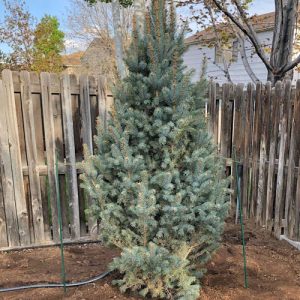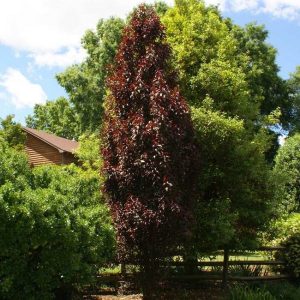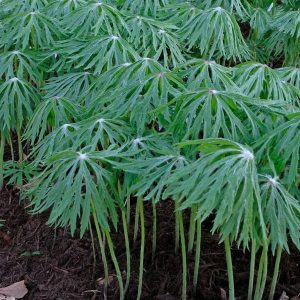Amazing Blooms Fast Growing Northern Catalpa
- Unique, Memorable Tree
- Huge White Flowers
- Fast Growing Native Tree
- Great Shade Tree
- Hardy
- Tolerates Wet Soils
The wonderful native Northern Catalpa tree (Catalpa speciosa) is near and dear to many people across the United States. If you are familiar with the sinuous, upright form and the very large, heart-shaped leaves, you already love it.
If you’ve ever seen a mature Catalpa in spring, you know it’s simply covered from top to bottom with the most amazing display of Azalea flower look-alikes. Each bell-shaped bloom features white petals and tiny rows of crimson dots and yellow throats. If you’ve seen it in bloom, you already love it, and so do hummingbirds.
This fast-growing tree is used as a municipal street tree. City planners use it to increase species diversity and protect the Elms and Ashes that grace our city streets. And as a large, ornamental shade tree, the Catalpa is no slouch.
This is one of the showiest native trees, and can be found along streams, creeks, and rivers throughout the Midwest. This gives it the ability to withstand wet soils. However, it’s very adaptable, and can be easily grown in just about any soil.
As a member of the Bignonia Family, it is related to Trumpet Vine, Royal Paulownia, and other species of Catalpa, all of which are known for their showy flowers. They are also notable for their fast rate of growth.
People have gifted it with many nicknames, including: Cigar tree, Catawba Tree, Hardy Catalpa, Western Catalpa, and Indian Bean Tree. The skinny fruits, which look like green beans, hang down from the branches and provide winter interest.
If you’ve got the room, Northern Catalpa really delivers. From the beautiful spring bloom, to the huge leaves – 12 inches across – that provide delicious shade quickly, this native tree can become a beloved feature for your family.
How to Use Northern Catalpa in the Landscape
This large tree should be given plenty of room to thrive. If used in a manicured part of the yard, or along the street, expect to do a bit of clean up with your mower after the flowers fade. On the plus side, the big leaves make fall raking easy. They can be shredded and composted without any trouble.
Another option is to use it in spots that are a bit wilder throughout your property.
If you have some room, consider restoring a portion of your property into a naturalized prairie. You’ll take out any bluegrass and put down the proper meadow seed mix for your area. Use a tractor or riding mower to carve out a mowed path through your meadow a few times a year. Then, place your Northern Catalpa as an enormous focal point.
It’s rough texture will really draw the eye. It becomes a perfect contrasting foil against waving, slender blades of prairie grass and the rugged perennial forbs.
You’ll love taking hikes out to the Catalpa to laze away under it’s wonderful shade. Put up a picnic table and include a fire pit a short distance away. The kids will love to camp out there, too. Don’t forget the hammock, or comfy Adirondack chairs.
A super place to site a Northern Catalpa is near a pond. You won’t worry about cleanup, and you’ll gain a second look at your flowering tree as reflected in the water. Beautiful!
If you live in wide open country, Catalpa make great plants to include in your shelter belts and windbreak areas. They grow quickly and reach a large size and keep their nice form.
Even on medium-sized lots, Catalpa are great choice to include in large Rain Gardens. Create one in a low area to collect runoff and filter rainwater. They can be used anywhere in the design, including the Wet, Mesic or Transition Zones.
Northern Catalpa (make sure you get the right variety!) is an excellent light hardwood with a large percentage of heartwood. Settlers used the wood for beams. Because the wood resists rot, it can also be shaped into long-lived fence posts.
With a neutral, grayish tan color that resembles Ash, Catalpa wood can be planed into flooring planks. It would be wonderful worked into clean-lined modern furniture, as well. It has a spicy scent, so save any curled shavings for dried potpourri mixes.
Entrepreneurs and fishermen, take note. One of the most interesting uses for Catalpa’s are as an orchard. Catalpa are a host plant for the Catalpa Sphinx Moth, and the caterpillars make excellent bait for sport fishing of catfish and largemouth bass. Southern anglers know them best as “catawba worms”, and will pay a premium for these small caterpillars, which can be sold commercially or online. Spread drop cloths out under the tree, and lightly shake the tree to gather your harvest. This would be a great first job for a young, money-minded teen, wouldn’t it?
Tips for Care
Give it regular water for best growth and less stress. However, Northern Catalpa are very adaptable once their roots are established in the soil.
Catalpa trees grows best in full sun, but they’ll handle a bit of shade, too.
Summer pruning can be done of any crossing branches. Catalpa does like to produce more than one leader when young, so watch for competing main stem leaders and simply remove them back to the main trunk.
The large size can sometimes outgrow the site quickly if not sited properly. Plant them where they can grow and develop naturally, so you will not have to restrict the plant. Site it correctly, and you’ll love it forever.









